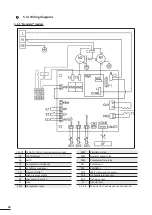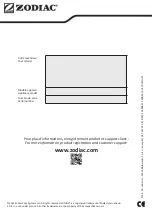
15
❹ Maintenance
4.1 I Winterizing
•
Winterizing is vital to prevent the condenser breaking due to freezing. This is not covered by
the warranty.
•
To avoid damaging the equipment with condensation, do not fully cover it.
•
Switch off the device by pressing and holding for 2 seconds and disconnect it or switch off the electricity supply,
•
Close the water input and output valves and make sure that there is no water circulating in the heat pump,
•
Drain the water from the condenser (risk of freezing) by unscrewing the water input and output connectors on the
back of the heat pump,
•
In the case of full winterizing for the pool (complete shutdown of the filtration system, bleed the filtration circuit
or even pool drainage): tighten the two connectors by one turn to prevent any foreign bodies from getting into the
condenser,
•
In the case of winterizing for the heat pump only (shutdown of the heating only, the filtration keeps running): to not
tighten the connectors but add 2 caps (provided) on the condenser's water inputs and outputs.
•
We recommend that you put the aired winterizing micro cover on the heat pump.
4.2 I Maintenance
•
It is recommended that the device be general servicing at least on a yearly basis to ensure
proper operation, maintain performance levels and prevent some potential failures. These
operations are carried out at the user's expense, by a technician.
4.2.1 Safety instructions for appliances containing R32 refrigerant
Area check
•
Before starting work on systems containing flammable refrigerants, safety checks must be carried out to guarantee a
minimal ignition risk.
Work procedure
•
The work must be carried out according to a controlled procedure in order to reduce the risks of releasing a flammable
gas or vapour while working.
General work area
•
All maintenance staff and other personnel working in the surrounding area must be made aware of the work carried
out. Work conducted in enclosed areas must be avoided.
Check for the presence of refrigerant
•
The area must be analysed using a suitable refrigerant detector before and during work so that the technician is
informed of the presence of a potentially toxic or flammable atmosphere. Check that the leak detection equipment
used is suitable for use with all refrigerants concerned, i.e. that it does not cause a spark, is correctly isolated or is
entirely safe.
Check for the presence of a fire extinguisher
•
If work must be carried out on the cooling equipment or any part associated therewith at a certain temperature,
suitable fire extinguishing means must be within reach. Place a dry chemical fire extinguisher or CO<g-
1776156949>2</g-1776156949> fire extinguisher near the work area.
No source of ignition
•
No person carrying out work on a cooling system involving exposing the piping may use any ignition source, which
could create a fire or explosion risk. All possible ignition sources, in particular cigarettes, must not enter within a
sufficient perimeter of the installation, repair, removal or disposal site, in the event that refrigerant could be released
into the surrounding space. Before starting the work, the area around the equipment must be examined to check for
all fire or ignition risks. “No smoking” signs must be displayed.
Area ventilation
•
Before accessing the unit in any manner whatsoever with the intention of performing any maintenance task, check
that the area is open and well-ventilated. Suitable ventilation must be provided throughout the maintenance task to
allow any refrigerant that could be released into the atmosphere to be safely dispersed.
Refrigeration equipment check
•
The manufacturer’s recommendations in terms of care and maintenance must always be complied with. When
replacing electric components, check that components used are of the same type and category as those recommended/
EN






















